Titans
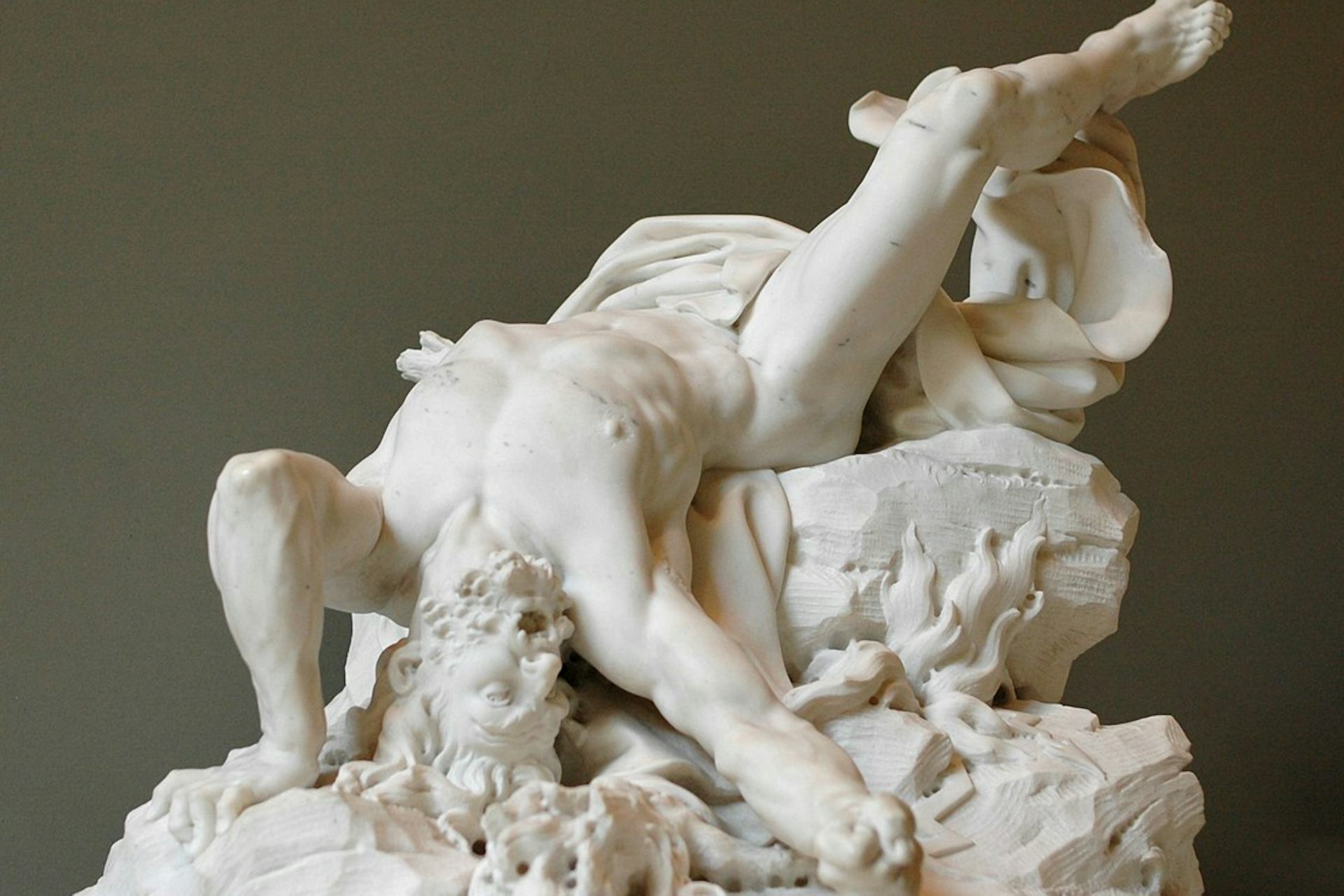
Titan Struck by Lightning by François Dumont (1712)
Louvre Museum, ParisPublic DomainOverview
The Titans were ancient gods of Greek mythology—children of Uranus and Gaia who dominated the cosmos before the Olympians. Cronus, the youngest Titan, became the ruler of the gods after he usurped his father Uranus. Fearing a similar fate, Cronus swallowed each of his children as soon as they were born in order to maintain his power.
But Zeus, Cronus’ youngest son, was saved by his mother Rhea. Once Zeus came of age, he freed his siblings from their fleshy prison, and together they waged a ten-year war against Cronus and the other Titans (the “Titanomachy”). In the end, the Titans were defeated. Most of them were imprisoned in Tartarus by the new gods, who were called “Olympians” after their home on Mount Olympus.
Though the Titans were often represented as cruel in Greek mythology, the period during which they ruled was nonetheless regarded as a Golden Age. Unlike the Olympians, however, the Titans were rarely worshipped in ancient Greece (though a few individual Titans, including Cronus and Rhea, did have important cults and festivals).
Etymology
There is no consensus on the etymology of the term “Titan” (Greek Τιτάν, translit. Titán; pl. “Titans,” Greek Τιτάνες, translit. Titánes).[1] Hesiod, the earliest source to describe the mythological origins of the Titans, suggested two etymologies: one from the Greek verb τιταίνω (titaínō), “to strain,” and one from the Greek noun τίσις (tísis), “punishment, vengeance.”[2] However, most modern scholars dismiss these as folk etymologies.
It is more likely that the term “Titan” originated long before Hesiod, probably from a non-Greek language. Walter Burkert, for instance, has posited that the term is of North Syrian origin—a plausible enough idea, considering that much of the mythology of the Titans is clearly modeled on Near Eastern and Semitic myths.[3]
Pronunciation
English
Greek
Titan, Titans Τιτάν (Titán), Τιτάνες (Titánes) Phonetic
IPA
[TAHYT-n, TAHYT-nz] /ˈtaɪt n, ˈtaɪt nz/
Attributes
Characteristics
The Titans were some of the first gods of the cosmos, immediately preceding the Olympians. Early literature does not provide any detailed descriptions of the Titans, but they were clearly imagined as anthropomorphic (that is, with the appearance and qualities of human beings).
There were initially twelve Titans (six male and six female), born from the union of the primordial gods Uranus (“Sky”) and Gaia (“Earth”). The early Greek poet Hesiod gives us their names and some of their individual characteristics:
deep-swirling Oceanus, Coeus and Crius and Hyperion and Iapetus, Theia and Rhea, Themis and Mnemosyne and gold-crowned Phoebe and lovely Tethys. After them was born Cronos the wily, youngest and most terrible of [Gaia’s] children, and he hated his lusty sire.[4]
These twelve Titans, like other Greek gods, were immortal and ageless. Led by Cronus, the youngest Titan, they overthrew their father Uranus to become the chief powers of the cosmos.
Originally, only the twelve anthropomorphic children of Uranus and Gaia were called Titans. Over time, however, different lists and groupings of Titans emerged; indeed, the very meaning of the term seems to have shifted. Some sources, for example, counted thirteen Titans: the twelve named by Hesiod plus either Phorcys[5] or Dione.[6]
Elsewhere, it was not only the original twelve Titans but also some of their immediate descendants who were called Titans. Thus, figures such as Atlas and Prometheus (the sons of Iapetus), Leto (the daughter of Coeus and Phoebe), and Eos, Helios, and Selene (the children of Hyperion and Theia) could all be numbered among the Titans.
Later sources further swelled the ranks of the Titans, often with highly obscure figures. For a comprehensive list of the various figures described as “Titans” in ancient sources, see here.
Adding to the confusion, the Titans were often conflated with the Giants, another race born from the earth goddess Gaia.[7] This may explain why the terms “titan” and “giant” are roughly synonymous in modern English, with both words referring to a being of great size—even though, interestingly enough, neither the Titans nor the Giants of Greek mythology were imagined as being exceptionally large.

Northern frieze from the Siphnian Treasury at Delphi (ca. 525 BCE) showing the Gigantomachy. The Giants are represented as hoplites.
National Archaeological Museum, Delphi / ZdeCC BY-SA 4.0Home
The Titans appear to have been associated with Mount Othrys, located in central Greece. (Mount Olympus, which would later become the home of the Olympian gods, was located further north.[8])
When the Titans were defeated by the Olympians, however, they were imprisoned in Tartarus, the darkest part of the Underworld. Hesiod writes that Zeus cast them down into this pit, with the Hecatoncheires—the “Hundred-Handers”—as their guards. There the Titans were
hidden under misty gloom, in a dank place where are the ends of the huge earth. And they may not go out; for Poseidon fixed gates of bronze upon it, and a wall runs all round it on every side. There Gyges and Cottus and great-souled Obriareus live, trusty warders of Zeus who holds the aegis.[9]
But not all of the Titans were banished to Tartarus. The female Titans (or “Titanesses”) seem to have remained free, and at least two of them—Themis and Mnemosyne—became important consorts of the new god Zeus.
Some of the male Titans were apparently not imprisoned either, perhaps because they sided with the Olympians during their conflict with Cronus. Oceanus, for instance, was not removed from his post as an important god of the sea (though it would have been impractical to send the embodiment of the world-encircling “ocean” down to Tartarus). Hyperion, the father of Eos, Helios, and Selene, seems to have been spared as well.
Some of the children of the Titans (who were sometimes regarded as Titans themselves) assumed key roles in the new world order of the Olympians. For example, the three children of Hyperion and Theia—Eos, Helios, and Selene—became important celestial gods: Eos became the embodiment of the dawn, Helios of the sun, and Selene of the moon. These gods, along with many of their descendants, made up the heavenly realm.
The sons of the Titan Iapetus were also important in Greek mythology. Atlas, for example, was forced to hold up the heavens on his shoulders, presumably as a punishment for some terrible crime against the Olympians (early sources do not explicitly name this crime).[10] Prometheus, another son of Iapetus, at first supported Zeus and the Olympians, but later fell from favor when he helped humanity against Zeus’ will. As punishment, Zeus had Prometheus chained to a cliff in the Caucasus Mountains, where an eagle would devour his liver each day.[11]
Iconography
There are no definite representations of the Titans in ancient art, at least not as a collective unit. However, a few depictions of individual Titans, including Oceanus, Hyperion, and Theia, have survived.[12]
Family
In the most widely accepted account—known above all from Hesiod’s Theogony—the Titans were the twelve children of the primordial gods Uranus and Gaia. Their siblings included the Cyclopes (Brontes, Arges, and Steropes) and the Hecatoncheires (Cottus, Briareus, and Gyges), as well as many other important early gods and creatures.[13]
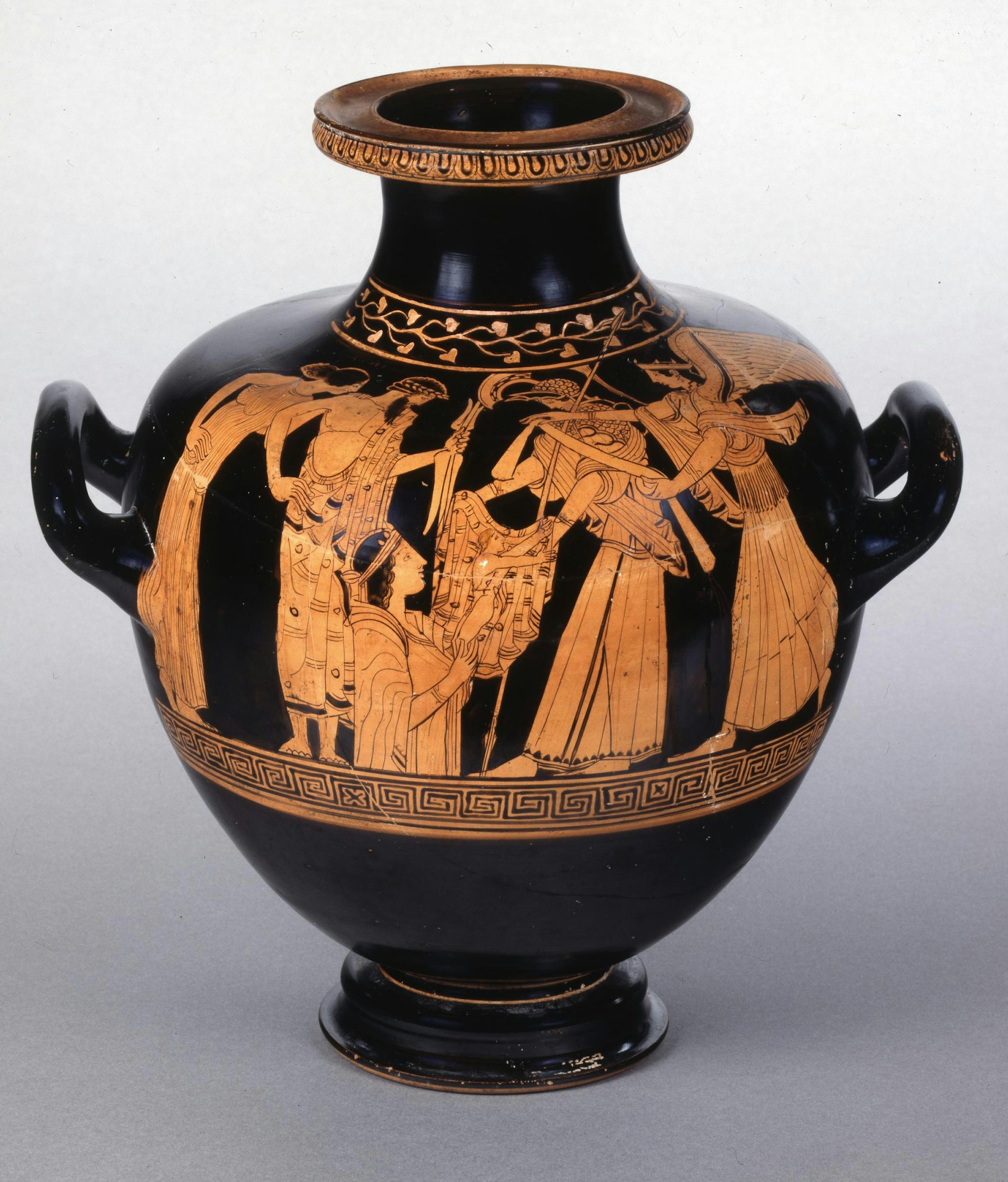
Attic red-figure hydria (water jug) showing Gaia (bottom center) in a scene from the birth of Erichthonius (ca. 450 BCE)
British MuseumCC BY-NC-SA 4.0However, there were other versions of the Titans’ parentage, too. In one very early tradition, Oceanus and Tethys (rather than Uranus and Gaia) were the first divine couple, and the Titans (plus Phorcys) were their children.[14] In another tradition, the father of the Titans was called Titan,[15] while in another they were the children of one of the Curetes and his consort Titaea.[16]
Eight of the twelve Titans married one of their siblings, thus forming four Titan couples. These were Oceanus and Tethys, who gave birth to the Oceanids and the Potamoi (“Rivers”);[17] Coeus and Phoebe, who gave birth to Leto and Asteria;[18] Hyperion and Theia, who gave birth to Eos, Helios, and Selene;[19] and Cronus and Rhea, who gave birth to the Olympians.[20]
Of the remaining Titans, two of the males had to find a wife outside of their immediate family. Iapetus married the Oceanid Clymene, with whom he fathered Atlas, Menoetius, Prometheus, and Epimetheus;[21] and Crius married Eurybia (daughter of Pontus and Gaia), with whom he fathered Astraeus, Pallas, and Perses.[22]
Finally, two of the Titanesses were saved for Zeus, becoming two of his earliest consorts. These were Themis, who gave Zeus the Horae and (according to Hesiod) the Moirae;[23] and Mnemosyne, who bore the nine Muses.[24]
Mythology
Origins
There are very clear parallels between many of the Greek cosmogonic myths—including the myths of the Titans—and the myths of the Near East. The Titans occupy an important position in the succession of divine rulers, a narrative that is sometimes referred to as the “Succession Myth.” Such succession myths were common in many world mythologies, especially those of the Greeks’ neighbors.
A particularly notable parallel comes from Hurro-Hittite mythology: Cronus’ castration and usurpation of his father, which was followed by his own usurpation by his son Zeus, can be compared to the myth of the Hurro-Hittite Kumarbi, who castrated and overthrew his predecessor Anu before being overthrown by his descendant Teshub (a storm god, just like Zeus).
There are other parallels between the Greek Titans and Near Eastern mythology. Though the Mesopotamian Enūma Eliš, which describes the rise to power of the god Marduk, is quite different from the myth of the Titans on a narrative level, Marduk’s treatment of his defeated rival Tiamat (the goddess of the sea) bears important similarities to Zeus’ treatment of the defeated Titans.
Because of these (and other) parallels, most scholars agree that the Greek Titans were first adopted from Near Eastern (especially North Syrian) models by the Greek city-states of western Anatolia and the Aegean. From there, they gradually spread to the rest of Greece.[25]
The Rise of the Titans
The Titans were born to the primordial couple Uranus and Gaia—the embodiments of the sky and the earth, respectively. But Uranus feared his powerful children. Wishing to prevent them from overthrowing him, he imprisoned the Titans beneath the earth along with their siblings—the Cyclopes, enormous one-eyed creatures, and the Hecatoncheires, or “Hundred-Handers.”[26]
Gaia hated Uranus for keeping her children trapped inside the earth (that is, inside of her). She therefore forged an unbreakable sickle of flint and begged her children to use it to punish their evil father. According to Hesiod, only the youngest of the Titans, Cronus, was willing to do the deed, though in some traditions all of the Titans except Oceanus participated in the bloody task. Cronus ambushed Uranus as he prepared to mate with Gaia and lopped off his genitals with the sickle that Gaia had given him.[27]
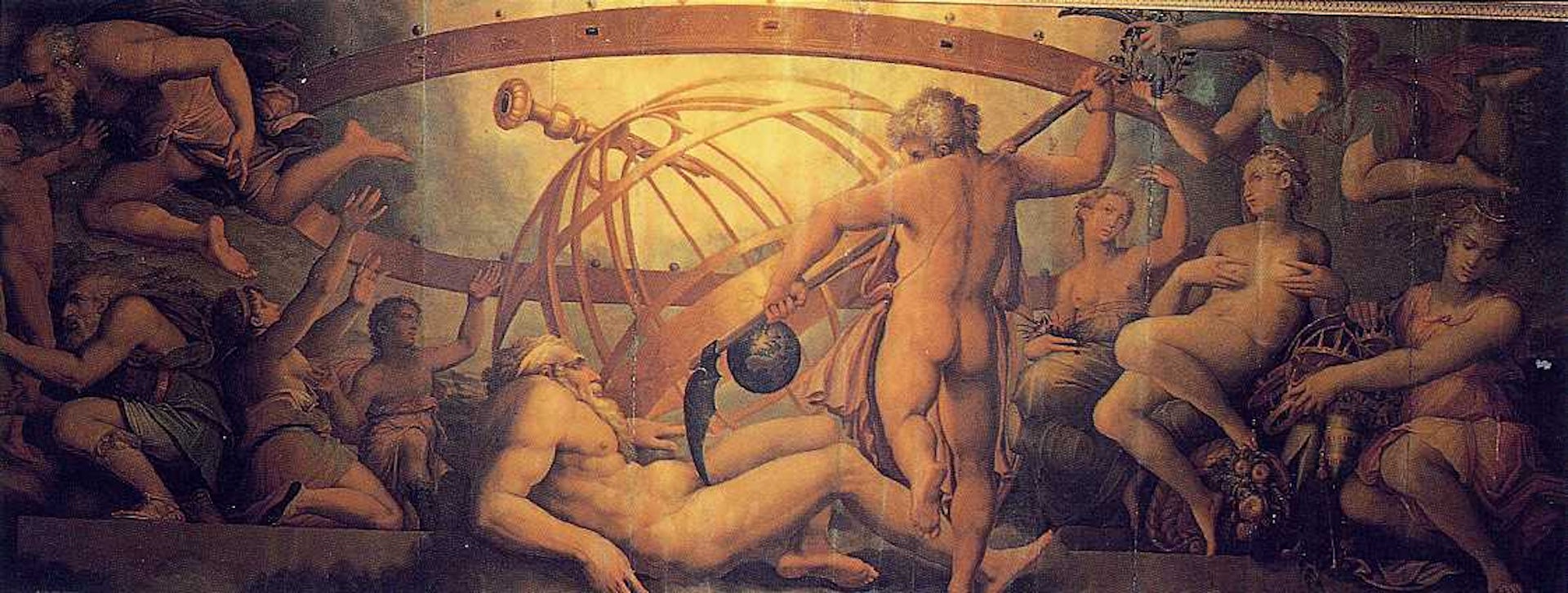
The Mutilation of Uranus by Saturn (Cronus) by Giorgio Vasari (16th century)
Palazzo Vecchio, Florence, ItalyPublic DomainAfter mutilating his father, Cronus became the new ruler of the cosmos. But he did not free the Cyclopes and Hecatoncheires—or, according to some traditions, he freed them briefly before changing his mind and reimprisoning them in Tartarus.[28]
The Titanomachy
The central myth of the Titans is known as the “Titanomachy,” or the “Battle of the Titans.” It tells the story of how the new Olympian gods fought and defeated the Titans in order to wrest control of the cosmos away from them.
Casus Belli
The causes of the Titanomachy lay precisely in Cronus’ attempts to prevent it. Cronus, like his father before him, was afraid of his children rising up against him; he therefore swallowed each of them as soon as his sister-wife Rhea gave birth. Cronus did this successfully to his first five children, but Rhea managed to save her sixth and final child, Zeus, through a trick: she hid Zeus from Cronus and instead gave her husband a stone wrapped in swaddling clothes. Cronus swallowed the stone, believing it to be his son.[29]
Zeus grew up in a cave, most likely located on the island of Crete. He was reared by nymphs with the help of the Curetes, young warriors who prevented Cronus from hearing the cries of baby Zeus by dancing around him and clashing their arms to muffle the sound. When Zeus came of age, he deceived Cronus into disgorging the children he had swallowed. Now fully grown, Zeus’ five siblings—Hestia, Demeter, Hera, Hades, and Poseidon—eagerly helped their younger brother wage war against Cronus and the Titans.[30]
The War
This marked the beginning of the Titanomachy, the war between the Titans and Cronus’ children (who became known as the Olympians after they made their base on Mount Olympus in northern Greece). Both sides mustered their forces. Most of the Titans joined their brother Cronus, while a handful of other gods, including the Oceanid Styx and her children—Zelos (“Rivalry”), Nike (“Victory”), Kratos (“Strength”), and Bia (“Force”)—joined forces with Zeus.[31] A few of the Titans, such as Styx’s father Oceanus, seem to have also sided with Zeus and the Olympians.[32]
The war lasted ten years, but Zeus finally gained the upper hand by releasing the long-imprisoned Cyclopes and Hecatoncheires.[33] These fearsome creatures gratefully joined forces with their liberators, and the Cyclopes gave Zeus the thunderbolt, which would forever be his preferred weapon and the symbol of his power.
With the Cyclopes and Hecatoncheires at their side, the Olympians attacked the Titans. In a violent battle, each of the Hecatoncheires pelted the Titans with boulders thrown from their hundred hands, while Zeus wielded his thunderbolt:
Then Zeus no longer held back his might; but straight his heart was filled with fury and he showed forth all his strength. From Heaven and from Olympus he came immediately, hurling his lightning: the bolts flew thick and fast from his strong hand together with thunder and lightning, whirling an awesome flame. The life-giving earth crashed around in burning, and the vast wood crackled loud with fire all about. All the land seethed, and Ocean’s streams and the unfruitful sea. The hot vapor lapped round the earthborn Titans: flame unspeakable rose to the bright upper air: the flashing glare of the thunderstone and lightning blinded their eyes for all that they were strong. Astounding heat seized Chaos: and to see with eyes and to hear the sound with ears it seemed even as if Earth and wide Heaven above came together; for such a mighty crash would have arisen if Earth were being hurled to ruin, and Heaven from on high were hurling her down; so great a crash was there while the gods were meeting together in strife.[34]
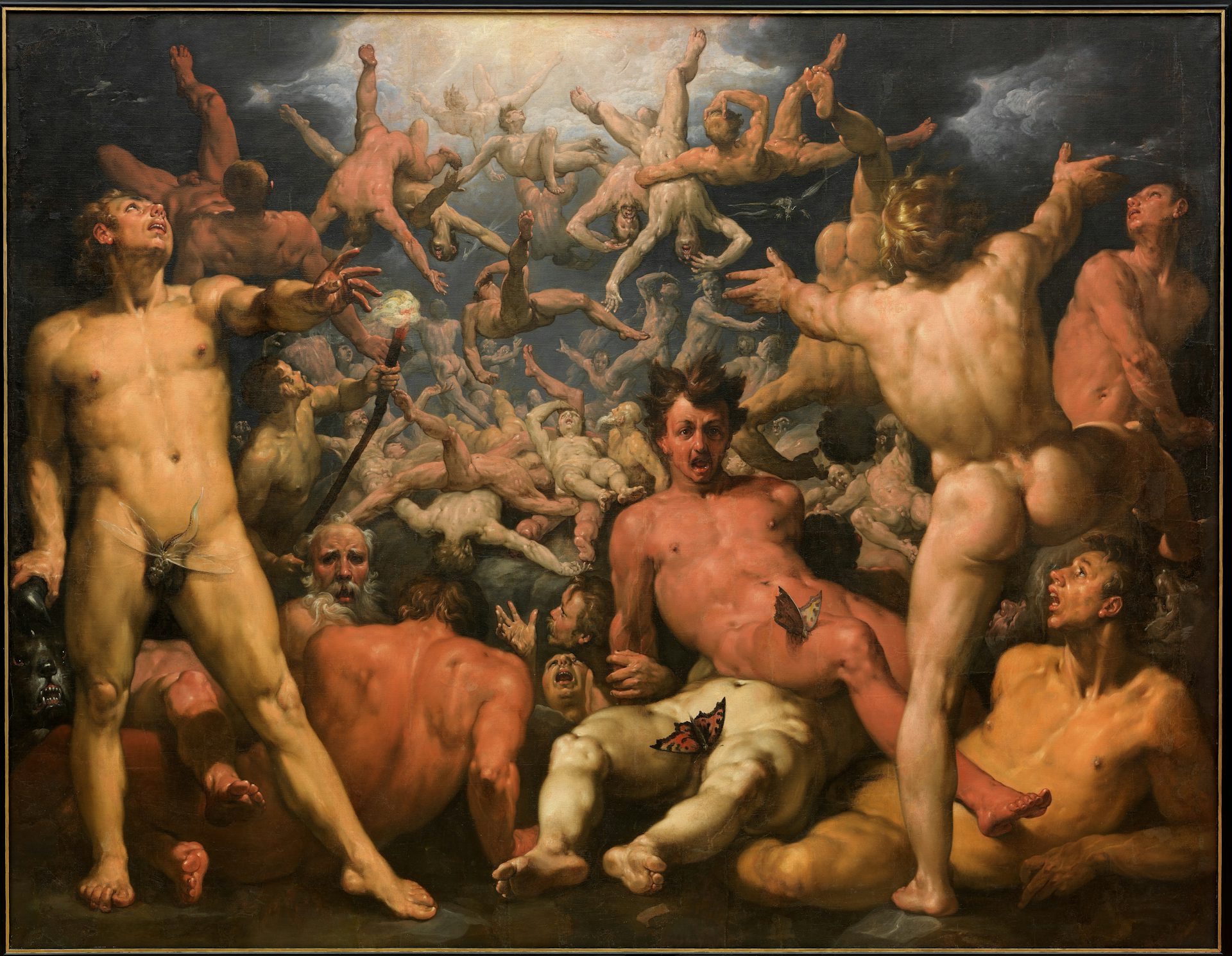
The Fall of the Titans by Cornelis van Haarlem (1588–1560)
SMK (National Gallery Denmark)Public DomainThe Fate of the Titans
After Zeus defeated the Titans, he imprisoned them in Tartarus and appointed the Hecatoncheires as their guards.[35]
But not all of the Titans were punished this way.[36] Oceanus (and perhaps Hyperion as well) seems to have favored the Olympians during the war and thus remained free; he certainly remained a powerful sea god under the new world order.
The sons of the Titan Iapetus, on the other hand, suffered uniquely terrible fates: Menoetius was blasted by Zeus’ thunderbolt and cast into the Underworld with the other Titans as punishment for his hubris;[37] Atlas was forced to support the heavens on his shoulders;[38] and Prometheus was ultimately chained to a rock, where an eagle pecked out his liver each day (punishment not for helping the Titans but for stealing fire from the gods to give to human beings).[39]
In many traditions, the Titans were eventually released from their torment. The poet Pindar wrote that Zeus ultimately freed all of the Titans except Atlas (who, of course, could not simply stop supporting the heavens).[40] Even Cronus was not imprisoned forever. Some said that he became the ruler of the Isles of the Blessed, where heroes spent their afterlife in unending bliss.[41] Others said that Cronus slept eternally on an island in the far north, beyond Britain, where he was watched over by the Hecatoncheir Briareus and many daemons.[42] Others still said that Cronus escaped to Italy, where he ruled over a utopian Golden Age.[43]
Other Versions
Some sources added further details to the tale of the Titanomachy, or even reported completely different versions of it.
In one tradition, Zeus and Cronus fought hand-to-hand at Olympia, and their battle marked the first wrestling match. This eventually became the site of the famous Olympic Games.[44]
In another tradition, closely associated with astrological lore, a half-goat creature called Aegicerus helped the Olympians win the Titanomachy. Aegicerus, who had been raised with Zeus, discovered that conch shells could be used as trumpets, and he weaponized the sound to scare the Titans during their battle with the Olympians. The grateful Zeus later turned Aegicerus into a constellation.[45]
Finally, there was one strange tradition in which Hera—Zeus’ wife—was the cause of the Titanomachy. In this account, Hera was angry that Zeus’ illegitimate son Epaphus ruled over such a large territory. She therefore convinced the Titans to rise up against the Olympians in order to punish her faithless husband. But Zeus defeated the Titans with the help of Athena, Apollo, and Artemis and threw his conquered foes into Tartarus.[46]
The Titans and Humanity
From a very early period, the Titans were associated with “anthropogony”—that is, the creation of human beings.[47] In Hesiod’s epics, it was Prometheus, the son of the Titan Iapetus, who was the first benefactor of human beings, teaching them crafts and religion and stealing fire from the gods to give to them.[48] Later accounts even made Prometheus the creator of human beings.[49]
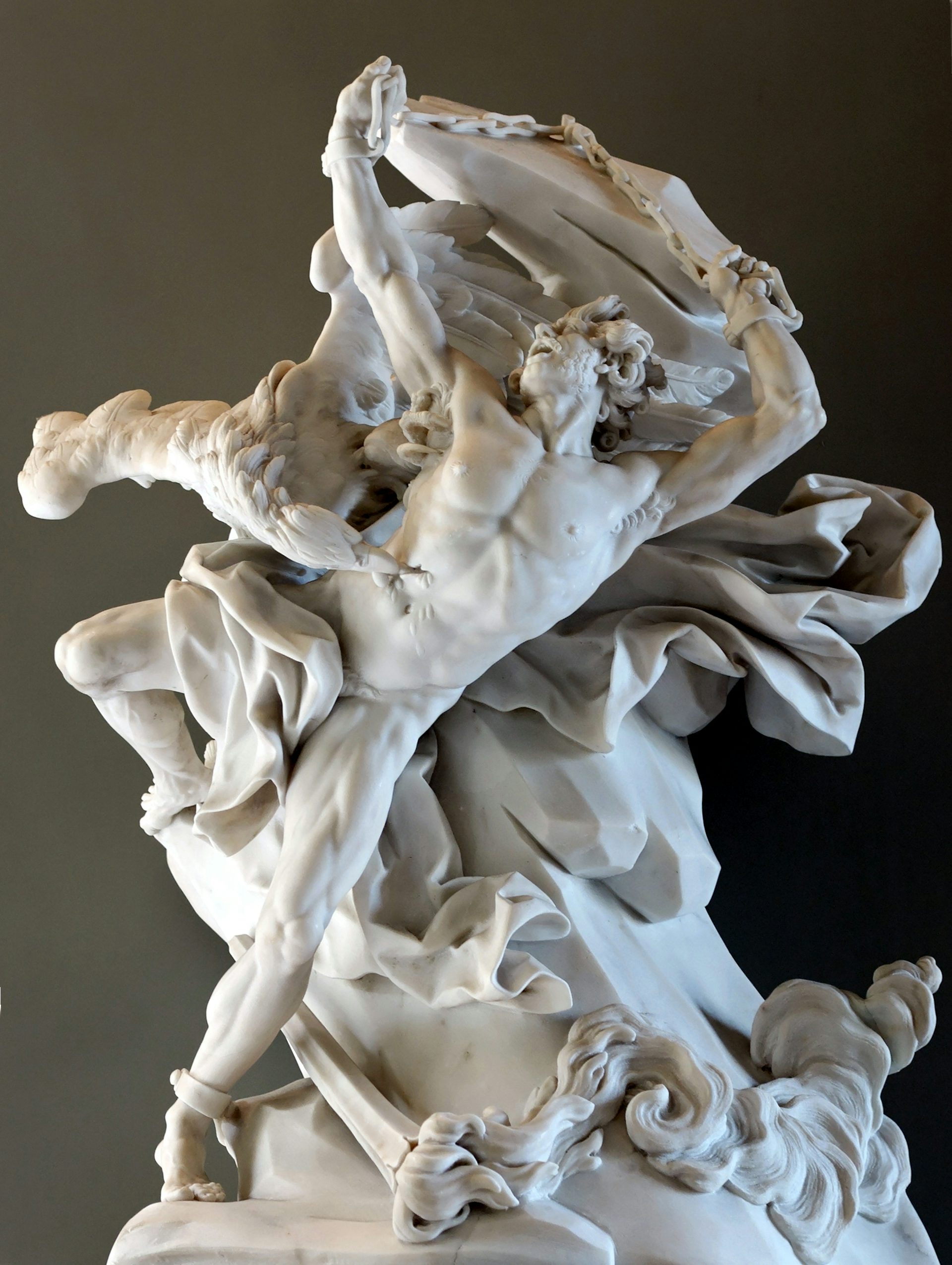
Prometheus by Nicolas-Sébastien Adam (1762)
Louvre Museum, ParisPublic DomainMeanwhile, the Orphics—a Greek religious sect known for their idiosyncratic beliefs and practices—told a strange and bloody story about the origins of human beings. According to Orphic accounts, the Titans tore apart and ate the god Dionysus, Zeus’ successor. In a fury, Zeus struck the Titans down with his thunderbolt, and humanity was created from the ashes. This myth was used to explain the violent tendencies of human beings: we are part Titan, after all. But human beings are also part Dionysus, and because of this Orphics considered it a terrible sin to commit suicide.[50]
Worship
The Titans were not widely worshipped in ancient Greece—at least not collectively. They certainly did not have the kind of expansive cult boasted by Olympian deities such as Zeus, Hera, and Athena. Some of the Titans, however, were worshipped independently.
Perhaps the most important of these was Cronus himself, who had a handful of temples in the ancient world. Cronus’ festival was known as the Cronia (or the Saturnalia in Rome) and was celebrated throughout the ancient world. The Cronia, which was associated with the annual harvest, was marked by ritual license and the temporary reversal of the social order, with masters and servants—and possibly even men and women—trading roles for a day.
Another Titan who had a presence in ancient cult was Rhea. There were some temples of Rhea in the Greek world, but she was most commonly worshipped in the guise of Cybele or the “Great Mother,” an Anatolian mother goddess whose flamboyant rituals spread to ancient Greece and Italy.
Pop Culture
The Titans have remained a fixture in Western culture. They feature in literary works such as Dante’s Divine Comedy, and their names grace various celestial bodies, including the planet Saturn (the Roman name for Cronus) and its moons (which are mostly named for individual Titans). In modern pop culture, the Titans tend to be grouped together with the Giants as large, powerful monsters that sought to overthrow the Olympians.[51]
The Titans have made several notable appearances in cinema. They are probably best remembered from the title of the 1981 film Clash of the Titans—though neither of the film’s “Titan” antagonists (the Kraken and Medusa) are actually Titans. In a number of films, including Disney’s Hercules (1997), Immortals (2011), and Wrath of the Titans (2012), characters plot to free the Titans in order to defeat Zeus.
This theme of freeing the Titans is popular outside of cinema as well. In Rick Riordan’s Percy Jackson and the Olympians novels, for example, the protagonist Percy Jackson (a son of Poseidon) must stop the Titans from breaking free from their Underworld prison and waging another war against the Olympians.
The Titans are also prominent in other contemporary media. The video game franchise God of War, for example, features several Titans (including Cronus) who seek to revolt against the Olympians. They have also appeared in other video games, including Final Fantasy and Age of Mythology. Finally, numerous sports teams have named themselves after the Titans; the New York Jets, for instance, were originally the New York Titans.